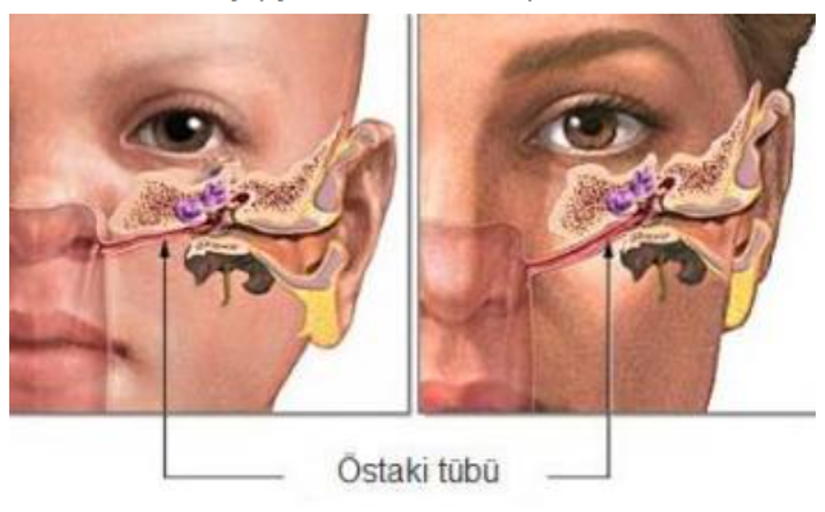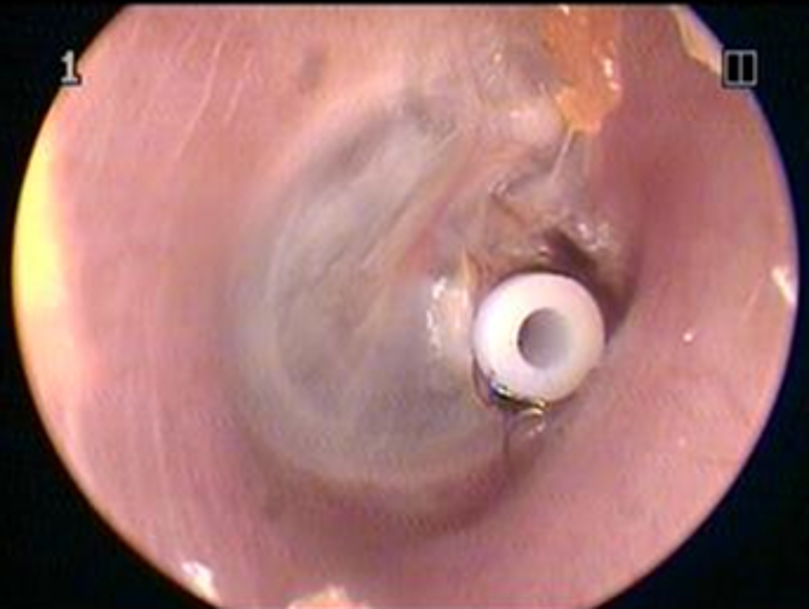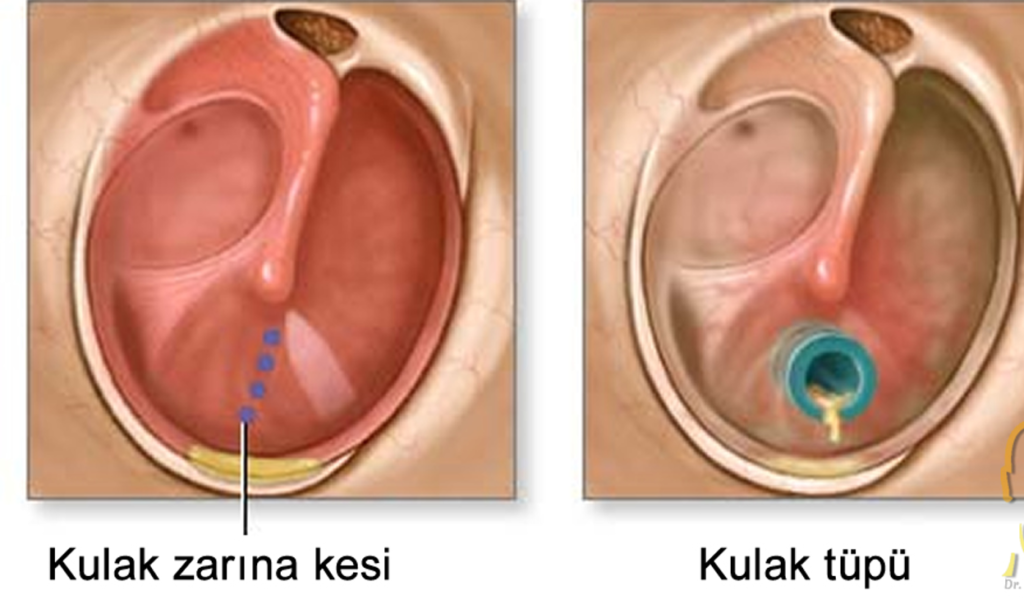Ear Fluid Accumulation and Ear Tube Insertion
Ear fluid accumulation can lead to hearing loss and an increased risk of infections due to fluid buildup in the middle ear. Treatment through ear tube insertion helps drain the fluid, ventilate the middle ear, and control hearing and infections.
Take the First Step Now
Free Preliminary Consultation
Schedule your free initial consultation with Prof. Dr. Mustafa Deniz Yılmaz now. Take the first step in your treatment process and let’s start your journey to regain your health with personalized solutions.
Eustachian Tube Dysfunction and Ear Tube Insertion

The Eustachian tube is a passage that connects the middle ear to the back of the nose, opening during swallowing and yawning to allow air into the middle ear. When this tube is blocked or does not open sufficiently, the air in the middle ear is absorbed, creating a pressure difference between the outer ear canal and the middle ear. This causes the eardrum to be pushed inward, disrupting sound transmission. Patients may experience this as fullness and blockage in the ear, while in children, it often leads to fluid accumulation in the middle ear and hearing loss.
Ear Tube Insertion
What is ear tube insertion?
Ear tube insertion (ventilation tube or tympanostomy tube) involves placing small tubes in the eardrum to treat fluid buildup and middle ear infections. These tubes ventilate the middle ear to prevent fluid accumulation behind the eardrum.

When is ear tube insertion necessary?
Ear tube insertion may be recommended in the following situations:
- Frequent middle ear infections
- Fluid accumulation in the middle ear (serous otitis media)
- Hearing loss
- Persistent pressure and pain due to prolonged fluid accumulation in the middle ear
How is ear tube insertion performed?
The procedure is usually performed under general anesthesia. A small incision is made in the eardrum, and a ventilation tube is inserted to ventilate the middle ear and prevent fluid buildup. The procedure takes about 15-20 minutes.

Is ear tube insertion painful?
Since the procedure is done under anesthesia, the patient does not feel pain. Mild discomfort or pain may occur after the surgery, but it is generally short-lived and can be managed with simple pain relievers.
How long do the tubes stay in place?
The tubes usually remain in place for 6 to 18 months. During this time, the incision in the eardrum heals naturally, and the tube eventually comes out. Regular follow-ups with the doctor are important until the tube falls out.
Do the tubes fall out on their own?
Yes, in most cases, the tubes fall out of the eardrum on their own. They may fall into the ear canal and are typically discarded without being noticed. If the tubes remain or do not fall out, they can be removed by a doctor.
Can fluid buildup recur after tube insertion?
Fluid accumulation generally improves and does not recur after tube insertion. However, in some cases, fluid may reaccumulate after the tube falls out, necessitating additional treatment.
Do the tubes damage the ear?
The tubes are generally a safe treatment method and do not damage the eardrum. However, in rare cases, a permanent hole may remain where the tube was inserted, which may require surgical intervention.
What precautions should be taken after tube insertion?
After tube insertion, it’s important to prevent water from entering the ear. Waterproof earplugs may be used during bathing or swimming. Antibiotic ear drops may also be prescribed to prevent infections.
Does hearing improve after tube insertion?
Yes, patients experiencing hearing loss due to fluid buildup in the middle ear generally experience quick improvement in hearing after tube insertion.
Does tube insertion prevent infections?
The tubes are effective in preventing fluid accumulation and related infections. However, middle ear infections can still occur after tube insertion, in which case the doctor may prescribe antibiotics.

Is ear tube insertion safe?
Ear tube insertion is a very safe surgical procedure, and serious complications are rare. However, as with any surgical procedure, there are small risks such as infection, bleeding, or the tube not staying in place.
Are there any complications during the ear tube insertion procedure?
Complications during the procedure are rare. The most common complications include post-procedure infection, premature tube fall-out, the tube not falling out, or a permanent hole in the eardrum.
What age group is ear tube insertion performed on?
Ear tube insertion is most commonly performed on children, as they are more prone to middle ear infections. However, it can also be applied to adults with fluid accumulation in the ear or chronic middle ear infections.
How is post-procedure follow-up managed after ear tube insertion?
After surgery, your doctor will regularly check your ear to ensure the tubes are working properly. The tubes generally stay in place for 6 to 12 months, during which time regular follow-up with your doctor is recommended.
Ear tube insertion is an effective treatment method for addressing middle ear infections and fluid accumulation. If you are experiencing these issues, you can consult an ENT specialist to learn more about this treatment option.
My nephew Ugur Karaer was suffering from empty nose syndrome. We went to every doctor in Istanbul. Finally, God brought us to Dr. Deniz. He performed the surgery successfully and saved my nephew's life. May God bless him.
I don't know how many surgeries I've had myself. But when it comes to children, everything calms down. 🙁 After seeing three doctors for my 2.5-year-old daughter's adenoid and tonsillectomy, we thankfully found Prof. Dr. Mustafa Deniz Yılmaz. His knowledge and patient approach made us believe he was by far the best doctor in this field. His assistant, secretary, the specialist who performed the hearing test... the entire team was extremely professional. Success is a team effort. That's why the whole process went smoothly, and we left satisfied. 💕 May God bless him 🙏🏻
We came from Almaty on vacation, and my son started having ear pain from the very first day. They recommended drops and medications, but nothing helped. We stumbled across a doctor online and decided to take a chance. She turned out to be wonderful, and after the first dose of medication, my son felt better. Within a week, there was no trace of the infection. Special thanks to the translator for her care, understanding, and professionalism.
I was suffering from empty nose syndrome. For those who don't know, I should say that almost all of my nasal tissue was removed. It is a very bad disease. I went to 100 ENT doctors in Istanbul and they couldn't find a solution. Finally, I found Deniz Hoca, who is an expert in this field, and he took cartilage from my rib and performed the surgery and I got better. Thank you very much for everything.
I had a tonsillectomy performed by our doctor, Mustafa Deniz Yılmaz. The surgery went smoothly, and although it's said to be more difficult for adults, I recovered very quickly. I'm so glad I chose Mustafa.
Hello, they told me that my parotid gland needed to be removed. I went to so many doctors that I finally decided on Dr. Mustafa. I am glad I chose Dr. Mustafa. You do not need to look for a doctor, you can choose my doctor with peace of mind without any worries.
I had a nose surgery 9 months ago by Mustafa Deniz Hoca. Both he and his team are always in touch with you before and after the surgery and provide detailed answers to questions. I am very pleased with my nose in terms of aesthetic appearance and health. Thank you and your entire team for everything.
First of all, I would like to thank my instructor Mustafa Deniz Yılmaz for his efforts. I had a nose surgery about 4 months ago. Like everyone else, I had the opportunity to research and compare the videos taken by many people who had this surgery and the perspectives of experts in their field on nose surgeries. I am very happy that I made the right decision and had surgery with my instructor Mustafa. I sincerely recommend my instructor Mustafa to everyone who wants to breathe both aesthetically and healthily and has problems.
I had a nose surgery in February. They never failed to show interest from the moment I entered the clinic until the last moment. No one even understands that I had plastic surgery. Mr. Deniz is one of the best in his field. I recommend it to everyone.
I had a nose surgery 3.5 months ago. The surgery and recovery process went great. There are a few things you should pay attention to after the surgery, they don't affect your quality of life too much. The doctor makes you feel very comfortable about that because it's not as complicated as you think. Other than that, I can breathe easily now, which is the most important thing. Also, Assistant Ayşegül Hanım gets back to you directly at any time of the day, no matter how long it has been since the surgery, if you have any questions. I'm very happy that I chose the right doctor.
I met Dr. Deniz upon the recommendation of another patient. He performed my ear surgery approximately 6 months ago with the diagnosis of Cholestatum. His care and follow-up of his patient both before and after the surgery for 6 months is commendable. I would also like to thank Dr. Deniz for his confidence in his patient and his friendly approach. I am in a much better position after the surgery, both in terms of hearing and risk of infection. I would like to thank Prof. Dr. Mustafa Deniz Yılmaz and his team.
I went to my dear teacher Deniz because of my breathing difficulties. He and his team were very cheerful and caring. My surgery was very successful and our doctor Deniz and his team were always caring throughout the process. We definitely recommend them, they are very knowledgeable, you will never regret it.

Anesthesia Type: General

Operation Time: 2-3 Hours

Pain: Mild

Length of hospital stay: 1 night

Recovery Time 7 days
Fill in the Form
Let us call you
Take the First Step Now
Free Preliminary Consultation
Schedule your free initial consultation with Prof. Dr. Mustafa Deniz Yılmaz now. Take the first step in your treatment process and let’s start your journey to regain your health with personalized solutions.



